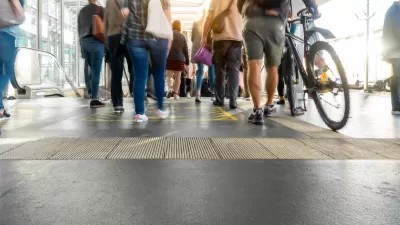Eric Jaffe traces the uneven history of private sector involvement in road construction and management. The involvement of public-private partnerships will likely continue to grow, despite the potential pitfalls.
"Public-private partnerships for infrastructure (often called PPPs or P3s) have been on the rise in recent years, and many experts believe the trend has yet to peak," observes Jaffe. "But as public-private partnerships become more common, there's a heightened fear that local governments are giving away too much in the deal. Some scholars, public interest groups, and lawmakers caution that PPPs often fail to deliver the improvements they promise, cuff the hands of local officials for generations, undermine comprehensive urban planning, and threaten the core value of roads as a public service. For every new attempt at PPP success, they say, there are multiple examples of partnerships that failed."
"No amount of concern is likely to curtail the rising interest in public-private partnerships," he adds. "Rather, their use only stands to increase as governments at all levels continue to struggle with new methods for funding transportation projects. Besides, PPPs offer elected officials the glitter of ribbon-cutting with the grit of fiscal austerity — all while limiting their responsibility for any toll hikes that might occur. They're high-quality political catnip."
FULL STORY: The Uncertain Future of Public Roads

Trump Administration Could Effectively End Housing Voucher Program
Federal officials are eyeing major cuts to the Section 8 program that helps millions of low-income households pay rent.

Planetizen Federal Action Tracker
A weekly monitor of how Trump’s orders and actions are impacting planners and planning in America.

Ken Jennings Launches Transit Web Series
The Jeopardy champ wants you to ride public transit.

Rebuilding Smarter: How LA County Is Guiding Fire-Ravaged Communities Toward Resilience
Los Angeles County is leading a coordinated effort to help fire-impacted communities rebuild with resilience by providing recovery resources, promoting fire-wise design, and aligning reconstruction with broader sustainability and climate goals.

When Borders Blur: Regional Collaboration in Action
As regional challenges outgrow city boundaries, “When Borders Blur” explores how cross-jurisdictional collaboration can drive smarter, more resilient urban planning, sharing real-world lessons from thriving partnerships across North America.

Philadelphia Is Expanding its Network of Roundabouts
Roundabouts are widely shown to decrease traffic speed, reduce congestion, and improve efficiency.
Urban Design for Planners 1: Software Tools
This six-course series explores essential urban design concepts using open source software and equips planners with the tools they need to participate fully in the urban design process.
Planning for Universal Design
Learn the tools for implementing Universal Design in planning regulations.
Ada County Highway District
Clanton & Associates, Inc.
Jessamine County Fiscal Court
Institute for Housing and Urban Development Studies (IHS)
City of Grandview
Harvard GSD Executive Education
Toledo-Lucas County Plan Commissions
Salt Lake City
NYU Wagner Graduate School of Public Service





























